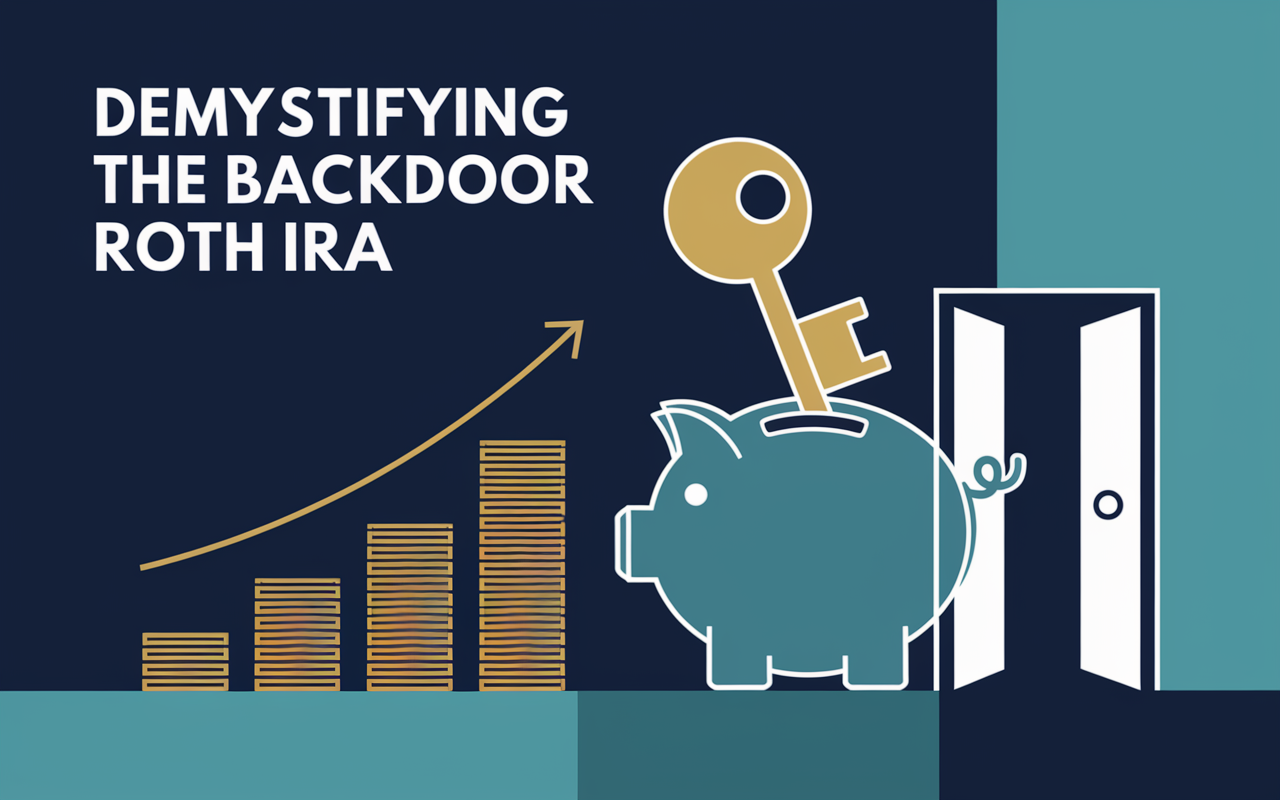Demystifying the Backdoor Roth IRA: A Strategic Guide
For many federal employees and military personnel nearing or already in retirement, rising income levels and long careers often lead to challenges in maximizing certain retirement accounts. For instance, those with incomes above annual IRS thresholds are shut out of direct Roth IRA contributions. That’s where the backdoor Roth IRA strategy comes in. It provides a pathway to access the same tax-free growth and distribution benefits that would otherwise be off-limits due to income restrictions. If you’ve been contributing steadily to your TSP and enjoying a successful federal career, you might wonder if this strategy is right for you. In this guide, we’ll take a friendly and comprehensive look at how backdoor Roth IRAs work, why federal employees should care, and which common pitfalls to avoid. We’ll also connect the dots between your Thrift Savings Plan, FERS or CSRS pensions, potential Social Security benefits, and the role a backdoor Roth IRA can play in your bigger picture.
If you’ve ever been told you make too much to fund a Roth IRA directly or you simply want to add more tax diversification to your overall strategy, keep reading. And if you’re searching for deeper, personalized insights, consider signing up for one of our free Federal Retirement Planning Workshops where we demystify concepts like these for federal employees.
What Is a Backdoor Roth IRA?
The phrase “backdoor Roth IRA” can be a bit misleading. There is no special type of “backdoor” account. Instead, it’s a legal technique high earners use to indirectly place funds into a Roth IRA despite being over the income limits for direct contributions. Typically, you put money into a traditional IRA on an after-tax (non-deductible) basis. Because there’s no tax deduction, it becomes your “basis” in the IRA. Soon afterward, you convert those dollars to a Roth IRA. If managed properly—especially if you don’t have other pre-tax IRA balances—you may incur little or no tax on the conversion. The result? You end up with Roth IRA dollars that grow tax-free, without running afoul of IRS rules on income limits.
Some federal employees worry the IRS might “flag” this maneuver. In practice, the IRS has never issued an express prohibition, and the conversion is permitted by law. The key is reporting the transaction correctly on Form 8606, which tracks the after-tax basis of your IRA contributions. This ensures you neither get double-taxed nor fail to pay required taxes on any pre-tax amounts. A backdoor Roth IRA is, in essence, a workaround for those who would otherwise be locked out of making annual Roth IRA contributions due to income thresholds.
The table below highlights the 2025 income-based phase-out ranges at which direct Roth IRA contributions are reduced or eliminated. If you fall into these brackets, you might consider a backdoor Roth IRA.
|
Filing Status |
Phase-Out Begins (2025 MAGI) |
Ineligible at |
|---|---|---|
|
Single / Head of Household |
$150,000 |
$165,000 |
|
Married Filing Jointly |
$236,000 |
$246,000 |
|
Married Filing Separately |
$0 |
$10,000 |
All Roth IRA rules still apply to the income you convert—so it’s critical to be careful about how other IRAs or TSP roll-ins factor into your situation. But first, why do certain high-earning federal employees and retirees even bother?
Why High-Earning Federal Employees Care
Federal employees, especially those approaching retirement, often have multiple sources of income in the mix. You might have your TSP, a Civil Service Retirement System (CSRS) or Federal Employees Retirement System (FERS) annuity, Social Security benefits (for FERS, or possibly CSRS Offset), plus personal investment accounts. The potential challenge is wrestling with required minimum distributions (RMDs) on your TSP and any traditional IRAs. Once you reach the mandatory RMD age (73 for most current retirees, increasing to 75 for those born in or after 1960), those forced distributions could push you into a higher tax bracket in retirement.
A Roth IRA, by contrast, is not subject to RMDs during your lifetime. That means you control when (and if) you withdraw those funds, which can help you manage and smooth out your taxable retirement income. Additionally, if you’ve already built a robust TSP balance—particularly if it’s mostly in the traditional side—converting at least part of your IRA dollars to Roth can offer significant tax diversification. That’s crucial in a climate of potential future tax rate hikes.
Some people ask, “If I already have the TSP Roth option, why add a backdoor Roth IRA?” Roth TSP contributions do offer tax-free growth, and beginning in 2024, Roth TSP balances are no longer subject to RMDs for the original account owner, thanks to the SECURE 2.0 Act. Prior to that change, rolling a Roth TSP to a Roth IRA was the only way to avoid those distributions. Even so, maintaining a separate Roth IRA can grant more flexibility, and certain investment opportunities might only be available in an IRA, giving you broader control of your portfolio.
Step-by-Step Backdoor Roth IRA Process
The appeal of the backdoor Roth strategy lies in its simplicity once you grasp the fundamentals. Nevertheless, each step demands accuracy. Any deviation—like forgetting to track after-tax contributions or failing to file the correct tax form—can lead to bigger-than-expected tax bills or, in worst cases, an unwelcome letter from the IRS.
Make a Non-Deductible Traditional IRA Contribution
The first step is contributing to a traditional IRA that you do not deduct on your taxes. For 2025, the maximum IRA contribution is $7,000 (or $8,000 if you’re 50 or older). Because your income is too high for a deductible traditional IRA contribution, you’re putting in after-tax money. Think of this as “seeding” the account with your tax-paid dollars. You’ll indicate on your tax return—via Form 8606—that you made a non-deductible contribution. This ensures the IRS knows part of your IRA basis is after-tax.
Convert to Roth IRA
Once the funds sit in the traditional IRA, the next step is transferring them to a Roth IRA. Some people convert immediately—referred to by some as a “same-day” or “same-week” conversion—to minimize any investment gains in the traditional IRA that would trigger taxable income. Others prefer to wait a short time. In practice, a quick turnaround is common and widely considered safe because the IRS has not issued any specific guidance prescribing a waiting period.
If you have existing IRAs that contain both pre-tax and after-tax amounts, your conversion will be subject to the pro-rata rule, meaning you convert a proportionate share of any pre-tax amounts. That can create a tax cost in the year of conversion. We’ll explore how some federal employees avoid that scenario shortly.
Report the Conversion on Form 8606
Filing Form 8606 with your tax return is not optional. This form tracks the after-tax IRA contributions you made, as well as the amount you convert to a Roth IRA. If you contribute $7,000 in after-tax dollars and immediately convert that same $7,000—without any additional IRA funds—there should be minimal or no tax on the conversion. Let’s say you contributed $7,000, and by the time you convert, it’s grown to $7,500. That extra $500 of growth would be taxable in the current year. Getting the math right on Form 8606 is crucial, so consult a qualified tax professional if you’re unsure. Errors can ripple through your future returns.
Key Rules & Gotchas
The backdoor Roth IRA is elegantly simple for those who have no pre-tax IRAs lying around. But if you do have a rollover IRA or anything else with pre-tax balances, there are a few crucial rules to keep top of mind.
The Pro-Rata Rule
The IRS lumps all your traditional IRA balances together to determine how much of your conversion is taxable. It doesn’t matter if you open a brand-new IRA for your backdoor contributions; the IRS sees a single combined IRA total. If 90% of your total IRA dollars are pre-tax, then 90% of your conversion is taxed as ordinary income. That’s called the pro-rata rule.
If you want to see this more clearly, look at the example table below. This scenario might not be yours exactly, but it shows how the concept works:
|
Total IRA Pre-Tax |
After-Tax Basis |
Conversion Amount |
Taxable % |
Tax Owed* |
|---|---|---|---|---|
|
$200,000 |
$10,000 |
$10,000 |
95% |
Ordinary Income on $9,500 |
*Tax owed depends on your marginal bracket in that year. Because 95% of your total IRA dollars are pre-tax, 95% of the conversion is taxable.
Aggregation Rule
This is part of the same concept. For conversion purposes, all traditional, rollover, SEP, and SIMPLE IRAs are aggregated. You can’t segregate pre-tax amounts in one IRA and after-tax amounts in another to magically avoid taxes. The IRS sees one big pot of money.
Step Transaction Doctrine
You may come across the argument that if you contribute to a traditional IRA and convert too soon, the IRS could claim it’s effectively a direct Roth contribution. Tax practitioners generally believe that as long as you fill out the paperwork properly and treat it as a genuine conversion, it’s acceptable. Many advisors counsel clients to wait a few days or even a few weeks between contribution and conversion to avoid any hint of impropriety, though the IRS hasn’t issued formal rules on timing.
Backdoor Roth IRA vs. Mega Backdoor Roth vs. TSP Roth Conversion
When exploring Roth solutions, you might stumble on “mega backdoor Roth” or TSP-based Roth conversions. They all share the goal of boosting your Roth account, but the mechanics vary. Here’s a snapshot of how they compare:
|
Strategy |
Contribution Limit 2025 |
Account Type |
Eligibility for Federal Workers |
Complexity |
Common Pitfalls |
|---|---|---|---|---|---|
|
Backdoor Roth IRA |
$7,000 ($8,000 if 50+) |
IRA (Traditional then convert to Roth) |
Yes, for those above Roth IRA income limits |
Moderate |
Pro-rata rule, improper Form 8606 filing |
|
Mega Backdoor Roth |
Up to 401(k) plan limits (potentially $70,000 total with after-tax contributions) |
Employer 401(k) or 403(b) with in-plan Roth conversion |
Rarely available in TSP; typically depends on private-sector plan |
High |
Plan must permit after-tax contributions and in-service conversions |
|
TSP Roth Conversion |
Standard TSP limits ($23,500 + catch-ups) |
Thrift Savings Plan |
Yes, for federal employees |
Moderate |
Roth TSP RMDs eliminated starting 2024; limited fund choices |
A “mega backdoor” Roth requires after-tax contributions to a 401(k) or similar plan. The TSP doesn’t currently allow after-tax contributions beyond the standard limit, so that high-limit option typically isn’t available for federal workers. Meanwhile, converting TSP balances to a Roth can be compelling in some scenarios, but it’s more restrictive—and you’d better plan for the tax bomb in the year you carry out that conversion. So the conventional “backdoor Roth IRA” remains the tried-and-true method for adding Roth assets if your income surpasses the direct contribution thresholds.
Advantages and Disadvantages
Backdoor Roth IRAs can be a powerful addition to a federal employee’s retirement arsenal, but like most strategies, they come with tradeoffs.
On the advantage side, the biggest benefit is the ability to secure tax-free compounding on money you otherwise couldn’t place in a Roth. As the years roll on, your Roth IRA grows completely sheltered from future tax hikes. You also get the benefits of no lifetime RMDs, meaning you decide when (or if) you withdraw those funds during retirement. That level of control can be invaluable for managing tax brackets, as can the ability to pass Roth IRA funds tax-free to heirs, provided certain conditions are met.
The downsides primarily revolve around tax complexity. If you have pre-tax IRAs, you’ll find the pro-rata rule cumbersome. You may owe a higher-than-expected tax bill if you convert more pre-tax dollars than you anticipated. Additionally, the extra reportorial burden on Form 8606 can trip up the unprepared. If your modified adjusted gross income is high enough, you might also stumble into higher Medicare premiums (IRMAA) if the taxable portion of your conversion puts you over certain thresholds.
For married couples in particular, close coordination helps ensure one spouse’s IRA activities don’t inadvertently create a surprise on the other spouse’s taxes. Some federal employees prefer to keep it simple by rolling any pre-tax IRA funds into the TSP first, thus isolating only after-tax dollars for the straightforward Roth conversion. This can neatly sidestep the pro-rata issue.
Case Study: Lieutenant Colonel Smith Turns a Tax Problem into Tax-Free Income
Imagine Lieutenant Colonel Smith, a retired military officer now working as a civilian at GS-14 pay. He’s 56 years old, earning about $195,000 a year including his pension. He wants to contribute to a Roth IRA, but his adjusted gross income is well above the IRS threshold. Over the years, he’s rolled his previous traditional IRA dollars into his TSP. Because the TSP accepts only pre-tax amounts, Smith is left with a $0 balance in any personal traditional IRAs.
Starting this year, he places $7,000 of after-tax money into a new traditional IRA. There’s no deduction for this, so he’s not lowering his current income. Within a week, he converts that $7,000 to his Roth IRA. On Form 8606, he reports the $7,000 after-tax contribution and indicates that the basis equals the entire amount. Tax owed on the conversion? Zero, assuming no investment gains occurred between contribution and conversion. Over the next 20 years, those dollars can grow tax-free. Lieutenant Colonel Smith is effectively building a second bucket of Roth money, separate from his Roth TSP. That flexibility can help him in his 70s if higher tax rates come into play or if he wants to leave a tax-free legacy to his children.
Implementation Checklist & Professional Guidance
If you’re curious about implementing a backdoor Roth IRA, here’s a concise roadmap:
First, assess your existing IRA balances. If you have a large pre-tax IRA, consider rolling it into your TSP (if you’re eligible) to isolate the after-tax basis and avoid heavy taxation under the pro-rata rule. Next, set aside the funds you’ll contribute after-tax, up to $7,000 or $8,000 depending on your age. After you make the contribution, watch for any short-term growth. Once you’re ready, execute the Roth conversion and track any gains that occurred. Lastly, file Form 8606 to correctly note your after-tax contribution and subsequent conversion.
This may sound straightforward, but the details can be tricky—and missing a single line item on your tax return can cause bigger issues later. Consulting with a credentialed professional familiar with federal benefits—a ChFEBC, CFP, or AIF—is often wise. If you’d like to see how this could fit into your comprehensive retirement plan, sign up for one of our free Federal Retirement Planning Workshops. We also encourage you to look at our Social Security & Tax Planning resources, our guide to TSP Roth versus Traditional, and articles on FERS annuity taxation to see how these pieces interlock.
Frequently Asked Questions
What is a backdoor Roth IRA and why was it created?A backdoor Roth IRA is a workaround strategy for those above the income limits for direct Roth IRA contributions. After-tax (“non-deductible”) IRA contributions are converted into a Roth IRA, allowing high earners to enjoy the benefits of tax-free growth and withdrawals.
Does the IRS endorse the backdoor method? The IRS hasn’t officially published a blessing, but they do allow Roth conversions generally, and they haven’t disallowed this technique in over a decade of usage. Documenting contributions on Form 8606 is key.
How do I avoid taxes if I already have a large Traditional IRA? Rolling pre-tax funds into a qualified employer plan (such as the TSP) can isolate your after-tax basis, reducing or eliminating the tax hit from the pro-rata rule.
Can I perform a backdoor Roth IRA every year? Yes, as long as you adhere to the rules, remain above the Roth IRA income thresholds, and manage your existing IRA balances appropriately. Many people repeat the process annually.
Is a backdoor Roth IRA better than contributing to my TSP Roth? It’s not necessarily “better” or “worse.” Both yield tax-free growth, but starting in 2024 Roth TSP balances are exempt from RMDs for the account owner. A Roth IRA still offers broader investment choices and no plan-level restrictions, so having both can enhance flexibility.
What happens if Congress changes the rules after I convert? As of 2025, there is no law banning the strategy. Congress reviews tax legislation periodically, but any changes typically include a timeline for effective dates. Roth conversions you’ve already completed are unlikely to be reversed retroactively.
In the bigger picture, the backdoor Roth IRA is just one element of a well-rounded retirement income plan. Learning how it meshes with your TSP, federal pension, and any other benefits you have can make a significant difference in how comfortably you spend your retirement years.
Ultimately, the hallmark of confident retirement isn’t just having multiple accounts—it’s having a coordinated, tax-savvy strategy that takes advantage of federal benefits and retirement vehicles in a holistic way. If you’d like to discuss how to implement a backdoor Roth IRA within your own portfolio, or simply get clarity on shaping a robust retirement plan, we invite you to join us at one of our Federal Retirement Planning Workshops. Our Fed-Expert Financial Blueprint can help you navigate the unique opportunities and challenges that federal service brings to the table.












